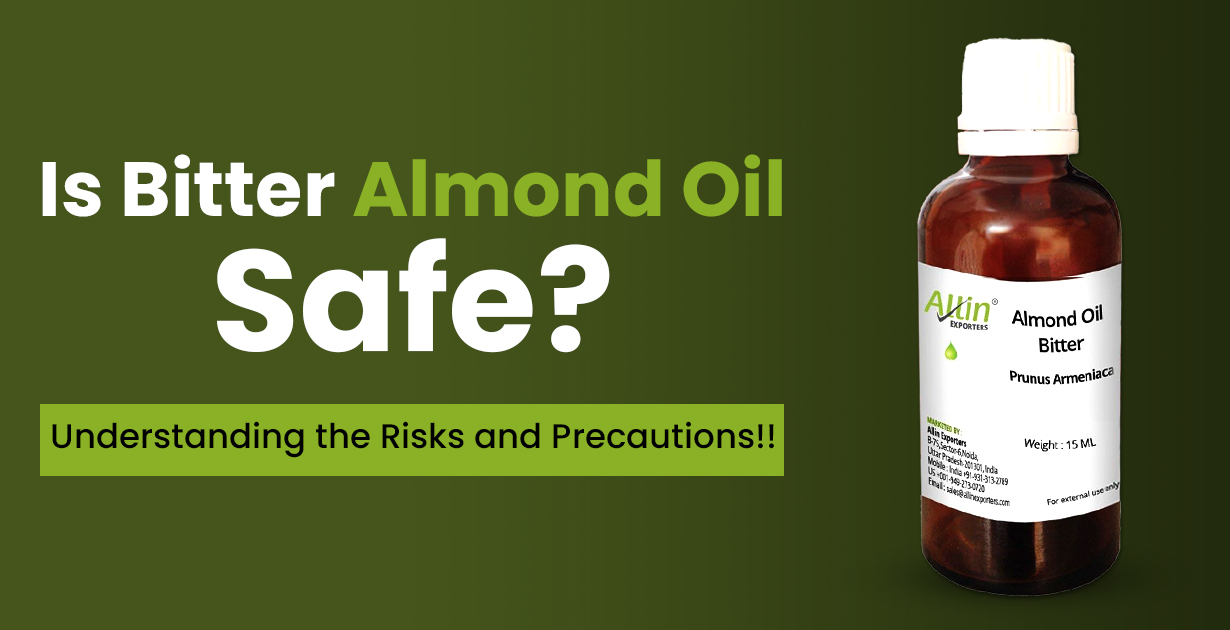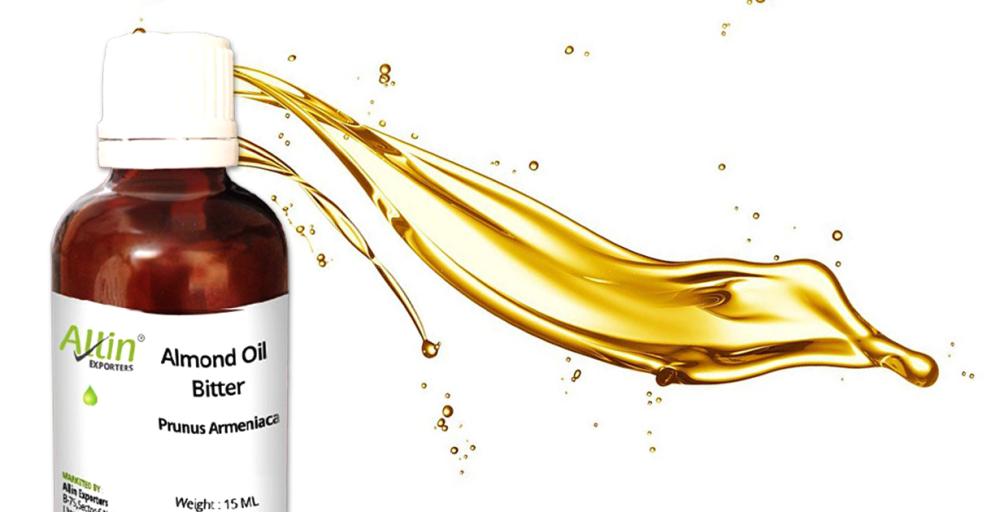Is Bitter Almond Oil Safe? Understanding the Risks and Precautions!!

Bitter almond oil is often hailed for its potential beauty and therapeutic benefits, but there is significant confusion and concern surrounding its safety. Derived from the seeds of bitter almonds (Prunus dulcis var. amara), this essential oil has been used in skincare, aromatherapy, and traditional medicine. However, its association with toxicity, particularly due to its cyanide content, raises questions about how and when it can be safely used. This article will help you understand the risks and precautions associated with bitter almond oil to ensure you can make informed choices.
What is Bitter Almond Oil?
Bitter almond oil is extracted from bitter almonds, which differ from sweet almonds, the source of the more commonly known sweet almond oil. Bitter almonds contain amygdalin, a naturally occurring compound that can break down into hydrogen cyanide, a highly toxic substance. While sweet almond oil is safe and frequently used in skincare and culinary products, bitter almond oil's potential toxicity makes its use more controversial.
Despite its risks, bitter almond oil has been used in traditional remedies for centuries, often applied topically or used in extremely diluted forms in aromatherapy. It is known for its antibacterial, antifungal, and anti-inflammatory properties, making it appealing for various health and beauty applications. However, its use must be approached with caution.
Understanding the Toxicity of Bitter Almond Oil

The primary concern with bitter almond oil is its cyanide content. Amygdalin in bitter almonds can release cyanide when it is metabolized by the body. Cyanide is a potent poison that can interfere with oxygen utilization in cells, leading to symptoms such as dizziness, headaches, nausea, and in severe cases, respiratory failure and death. The ingestion of just a few bitter almonds can be fatal, especially for children.
It’s essential to distinguish between natural bitter almond oil and processed or synthetic versions. In some cases, bitter almond oil is processed to remove the cyanide, making it safer for use in aromatherapy and other applications. However, unprocessed natural bitter almond oil is highly toxic if ingested and should never be used for internal consumption without professional supervision.
Topical Use of Bitter Almond Oil: Is It Safe?
For topical applications, bitter almond oil may still pose risks, especially if applied in its undiluted form. However, when properly diluted with a carrier oil (such as sweet almond oil, jojoba oil, or coconut oil), it can be used safely for external treatments. Bitter almond oil is often marketed for its antimicrobial and anti-inflammatory properties, and some people use it to treat acne, dry skin, or fungal infections.
While bitter almond oil can provide some skin benefits, its topical use should always be approached cautiously:
- Patch Test First: Before applying bitter almond oil to your skin, perform a patch test by applying a small, diluted amount to a less sensitive area, such as your wrist. Wait 24 hours to see if any irritation, redness, or allergic reactions occur.
- Avoid Sensitive Areas: Do not apply bitter almond oil to sensitive areas like the eyes or lips, as it can irritate.
- Dilution is Key: Always dilute bitter almond oil with a suitable carrier oil. A recommended ratio is 1-2 drops of bitter almond oil per tablespoon of carrier oil.
Aromatherapy and Bitter Almond Oil: How to Use It Safely
Bitter almond oil is occasionally used in aromatherapy, but it’s crucial to ensure that the oil you're using is free of cyanide or has been specifically processed for safe use. Aromatherapy oils are typically inhaled or diffused to promote relaxation, reduce stress, or improve mood, and bitter almond oil is sometimes used in blends to create unique fragrances.
Safety tips for using bitter almond oil in aromatherapy:
- Consult a Professional: If you plan to use bitter almond oil in your aromatherapy practice, consult a certified aromatherapist who can ensure the oil you are using is safe and properly processed.
- Use Sparingly: Bitter almond oil should be used sparingly, even in diffusers, as inhaling too much of the oil may still pose a risk.
- Never Ingest: Even in the context of aromatherapy, avoid ingesting bitter almond oil in any form, as it can lead to poisoning.
Potential Health Benefits of Bitter Almond Oil

Despite its risks, bitter almond oil offers a range of health benefits when used safely:
- Anti-inflammatory Properties: Bitter almond oil has been traditionally used to reduce swelling and inflammation when applied topically in diluted forms. It can help alleviate joint pain, muscle soreness, and skin inflammation.
- Antimicrobial Effects: Its natural antimicrobial properties make it a candidate for treating fungal and bacterial infections, especially for conditions like athlete's foot or skin infections.
- Antioxidant Support: Bitter almond oil contains antioxidant compounds that can help fight free radicals, potentially supporting skin health and delaying the visible signs of aging.
Precautions When Using Bitter Almond Oil
To ensure safety, consider these critical precautions when using bitter almond oil:
- Avoid Ingestion: The most significant risk with bitter almond oil comes from ingestion. Never consume bitter almond oil without professional guidance, as even small amounts can be lethal.
- Consult a Healthcare Provider: If you have any health conditions or are pregnant or breastfeeding, it’s essential to consult a healthcare provider before using bitter almond oil, even topically.
- Store Properly: Keep bitter almond oil out of reach of children and pets. Its potent toxicity makes it dangerous if accidentally ingested.
- Use in Moderation: Even when using it for external purposes, limit the amount of bitter almond oil you apply, and always ensure it is diluted with a carrier oil.
- Discontinue Use if Reactions Occur: If you experience irritation, redness, or any allergic reactions after using bitter almond oil, discontinue use immediately and consult a healthcare professional if necessary.
Conclusion
Bitter almond oil, with its history of use in traditional medicine and skincare, does offer some potential health benefits, particularly in its diluted and processed forms. However, the inherent risks associated with its cyanide content make it a substance that must be used with great caution. Whether you’re applying it topically or using it in aromatherapy, the key is to ensure that you are using a safe, processed version of the oil and always diluting it appropriately.
If you’re new to bitter almond oil or unsure about its usage, it’s best to consult with a professional before incorporating it into your wellness or beauty routine. With the right precautions, you can safely explore the benefits of this powerful oil while avoiding its potentially harmful effects.
FAQ's
Bitter almond oil can be used topically when diluted with a carrier oil. However, a patch test is essential to avoid irritation or allergic reactions.
No, bitter almond oil contains toxic cyanide compounds. Ingesting it can be dangerous or even lethal. Always avoid consuming bitter almond oil.
The primary risk is cyanide toxicity, which can cause serious health issues if ingested. Even topical use should be approached with caution and proper dilution.
Some processed versions of bitter almond oil are made safe for external use or aromatherapy, but always check labels to ensure it is cyanide-free.
Always dilute the oil, avoid ingestion, and consult a healthcare provider before use, especially if you are pregnant, breastfeeding, or have a medical condition.








